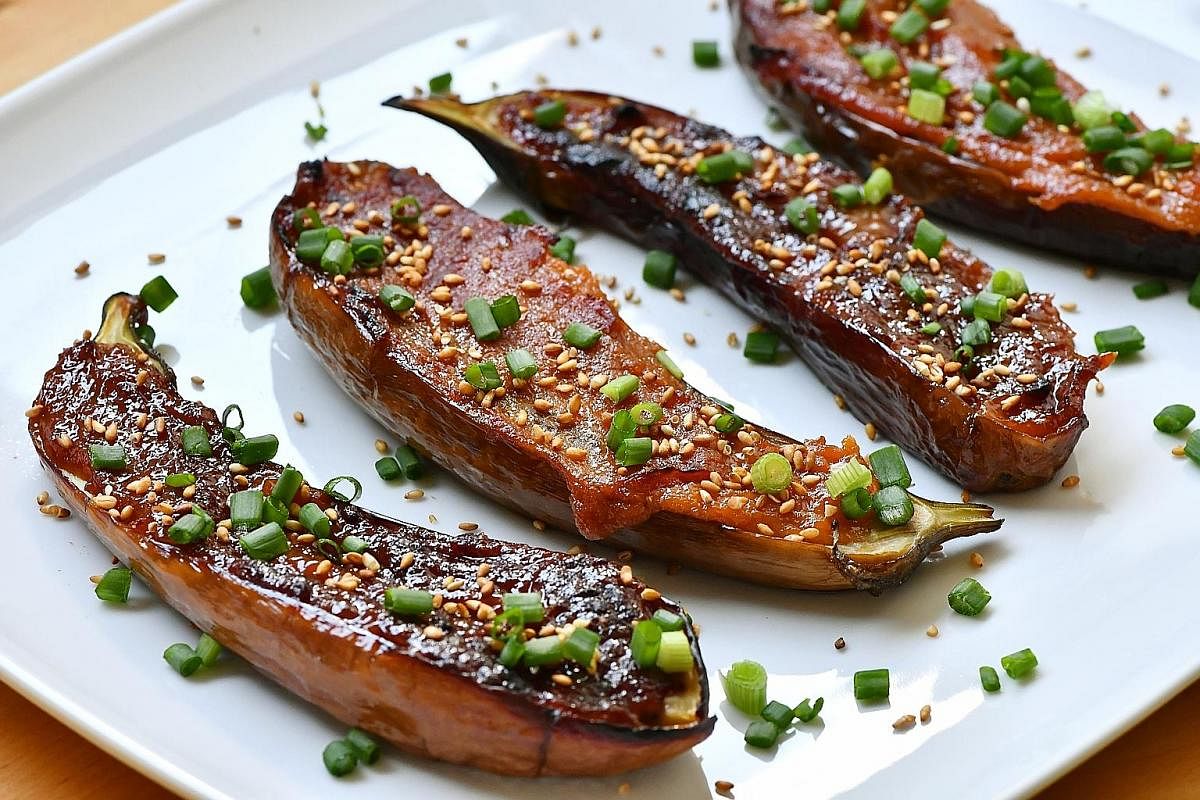-
MISO-GLAZED EGGPLANT
-

INGREDIENTS
600 to 700g medium eggplant
1 Tbs grapeseed or other cooking oil
150g awase (above left) or shiro miso (above right)
2 Tbs sugar
2 Tbs cooking sake
2 Tbs mirin
1 Tbs toasted sesame seeds
Chopped scallions
-
METHOD
1. Preheat oven to 180 deg C. Line a large baking tray with foil or parchment paper.
2. Rinse the eggplant under running water and wipe dry with paper towels. Halve the eggplant lengthwise. Using a sharp knife, score a cross-hatch pattern on the cut surfaces (below).

3. Place the eggplant halves on the baking tray in one layer, cut side up. Rub them all over with the oil. Roast for 20 minutes. If using smaller eggplant, check after 15 minutes. A fork should go through the eggplant easily. If using a larger eggplant, roast for 30 to 40 minutes or until the a fork goes through it with no resistance.
4. While the eggplant is cooking, make the glaze. Place the miso, sugar, sake and mirin in a small saucepan set over medium heat. Cook, stirring constantly, until the sugar has dissolved and the mixture becomes a smooth paste. Let it bubble for about 30 seconds. Switch off the heat and set aside until the eggplant is ready.
5. Remove the baking tray from the oven and turn on the grill function of the oven. This means only the top heating element comes on.
6. Divide the miso glaze among the eggplant and spread it evenly on the cut sides with a teaspoon.
7. Place the tray back in the oven, close to the top. Do not let the eggplant touch the heating coils. Grill for five to seven minutes or until the miso is bubbling and there are caramelised patches.
8. Remove the tray from the oven, transfer the eggplant to a serving platter. Sprinkle the toasted white sesame seeds and scatter the scallions over the eggplant. Serve immediately with rice.
Serves four as part of a meal with other dishes
-
ST PHOTOS: LIM YAOHUI
Hunger Management
Simply irresistible: Roasted eggplant with a miso glaze
Roasted eggplant with a miso glaze warms the belly and is perfect for rainy nights

There is nothing wrong with steaming or stir-frying vegetables, but roasting them pays rich dividends with little effort.
Brussel sprouts tossed with olive oil and roasted until lightly charred; purple carrots all in a row, slightly wrinkled and mighty sweet; and even roasted broccoli and cauliflower, perhaps sprinkled with some breadcrumbs and citrus zest; they all make my mouth water.
Time in the oven concentrates the flavours and the charred bits are completely irresistible, to me, at least.
One of my favourite vegetables to roast is eggplant, which picks up a smoky flavour in the oven.
Sometimes, I scoop out the soft insides and make baba ghanoush, a dip with tahini and chopped parsley, so delicious with warm triangles of pita bread.
I make an easy starter of thick slices of roasted eggplant, rubbed with za'atar and topped with ricotta cheese and pomegranate arils too.
But hands down, my favourite way of eating eggplant is the Japanese way - miso glazed.
The dish, called nasu dengaku, is a staple in Japanese restaurants that serve family-style food. Usually, the eggplant is deep-fried, then smeared with miso and grilled.
The thought of deep-frying anything fills me with horror, so I compromise and let the oven do all the work.
Supermarkets, grocery shops and wet markets have a bewildering range of eggplant. I rather like Pearl Brinjal, available in FairPrice supermarkets. But really, you can use any kind of eggplant. Look for those that are firm and heavy for their size.
Halve them, score the cut surfaces with a cross-hatch pattern so they get really soft when roasting. If using smallish Pearl Brinjal, 20 minutes is all it takes to get them soft and yielding. Check after 15 minutes if using smaller eggplant and roast for 30 to 40 minutes if using large ones. If a fork poked into the flesh does not meet resistance, the eggplant is done.
Then it is a simple matter of turning on the grill function of the oven, slapping the miso on the eggplant and grilling until caramelised.
Nasu dengaku is usually glazed with hacho miso, which is made with soya beans instead of rice and is much darker and richer in flavour. I have not found one that I like, so I use either shiro or white miso, or awase miso, which is a mix of white and red miso.
Awase has greater depth of flavour, but is also more salty. So shiro miso might be a good compromise.
The glaze comes together easily, with the addition of cooking sake and mirin. If you cook Japanese food often, you will realise just how much sugar is in the recipes.
For this one, white or brown sugar are fine, but I use Lakanto, a zero-calorie sweetener made from luo han guo or monkfruit. I order it from iHerb and use it spoon for spoon to replace sugar in my cooking.
Do not leave out the toasted sesame seeds and scallions. They add extra layers of flavour and a light crunch to the eggplant.
I like to eat the entire eggplant, skin and all, but if you prefer just the flesh, scoop it out with a teaspoon.
Rice is the perfect accompaniment, mitigating some of the saltiness from the miso.
On a rainy night, like the ones we keep having, nasu dengaku is belly-warming.
In fact, it is pure comfort.
Join ST's Telegram channel and get the latest breaking news delivered to you.
A version of this article appeared in the print edition of The Sunday Times on September 24, 2017, with the headline Simply irresistible: Roasted eggplant with a miso glaze. Subscribe


